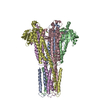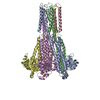+Search query
-Structure paper
| Title | Cryo-EM structures of human magnesium channel MRS2 reveal gating and regulatory mechanisms. |
|---|---|
| Journal, issue, pages | Nat Commun, Vol. 14, Issue 1, Page 7207, Year 2023 |
| Publish date | Nov 8, 2023 |
 Authors Authors | Louis Tung Faat Lai / Jayashree Balaraman / Fei Zhou / Doreen Matthies /  |
| PubMed Abstract | Magnesium ions (Mg) play an essential role in cellular physiology. In mitochondria, protein and ATP synthesis and various metabolic pathways are directly regulated by Mg. MRS2, a magnesium channel ...Magnesium ions (Mg) play an essential role in cellular physiology. In mitochondria, protein and ATP synthesis and various metabolic pathways are directly regulated by Mg. MRS2, a magnesium channel located in the inner mitochondrial membrane, mediates the influx of Mg into the mitochondrial matrix and regulates Mg homeostasis. Knockdown of MRS2 in human cells leads to reduced uptake of Mg into mitochondria and disruption of the mitochondrial metabolism. Despite the importance of MRS2, the Mg translocation and regulation mechanisms of MRS2 are still unclear. Here, using cryo-EM we report the structures of human MRS2 in the presence and absence of Mg at 2.8 Å and 3.3 Å, respectively. From the homo-pentameric structures, we identify R332 and M336 as major gating residues, which are then tested using mutagenesis and two cellular divalent ion uptake assays. A network of hydrogen bonds is found connecting the gating residue R332 to the soluble domain, potentially regulating the gate. Two Mg-binding sites are identified in the MRS2 soluble domain, distinct from the two sites previously reported in CorA, a homolog of MRS2 in prokaryotes. Altogether, this study provides the molecular basis for understanding the Mg translocation and regulatory mechanisms of MRS2. |
 External links External links |  Nat Commun / Nat Commun /  PubMed:37938562 / PubMed:37938562 /  PubMed Central PubMed Central |
| Methods | EM (single particle) |
| Resolution | 2.8 - 3.6 Å |
| Structure data | EMDB-41624, PDB-8tul: EMDB-41628, PDB-8tup:  EMDB-41629: Cryo-EM structure of the human MRS2 magnesium channel under Mg2+ condition (C1 map)  EMDB-41630: Cryo-EM structure of the human MRS2 magnesium channel under Mg2+-free condition (C1 map) |
| Chemicals |  ChemComp-MG:  ChemComp-HOH: |
| Source |
|
 Keywords Keywords | METAL TRANSPORT /  Magnesium / Magnesium /  Ion channel / Ion channel /  Membrane protein / Ion Translocation / Divalent Ion / Membrane protein / Ion Translocation / Divalent Ion /  Pentamer Pentamer |
 Movie
Movie Controller
Controller Structure viewers
Structure viewers About Yorodumi Papers
About Yorodumi Papers








